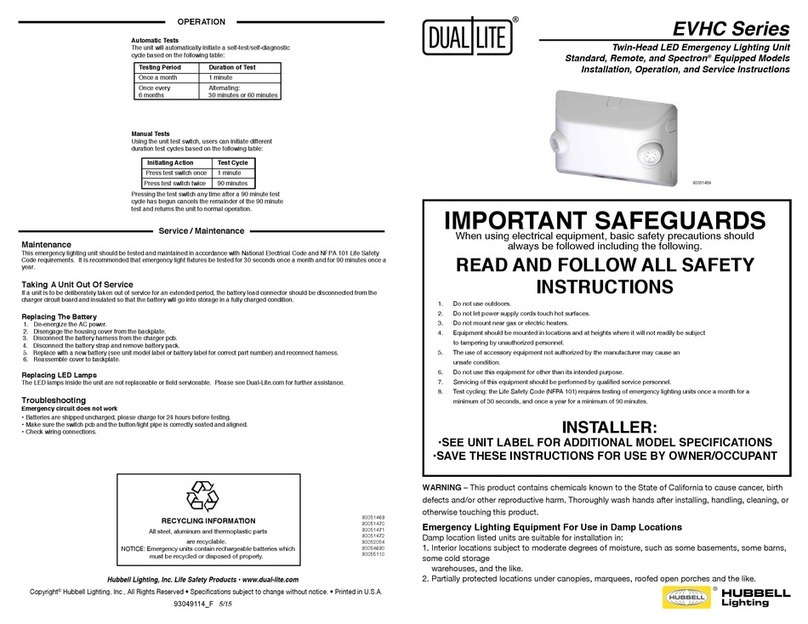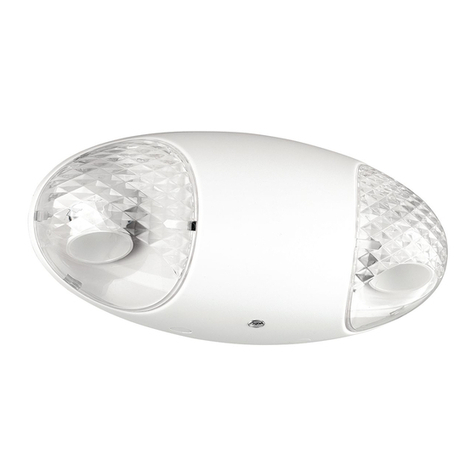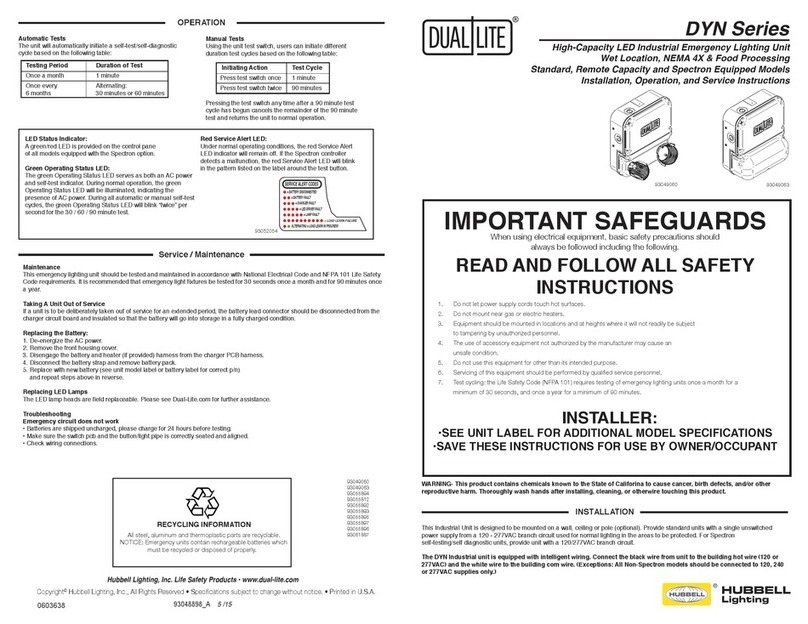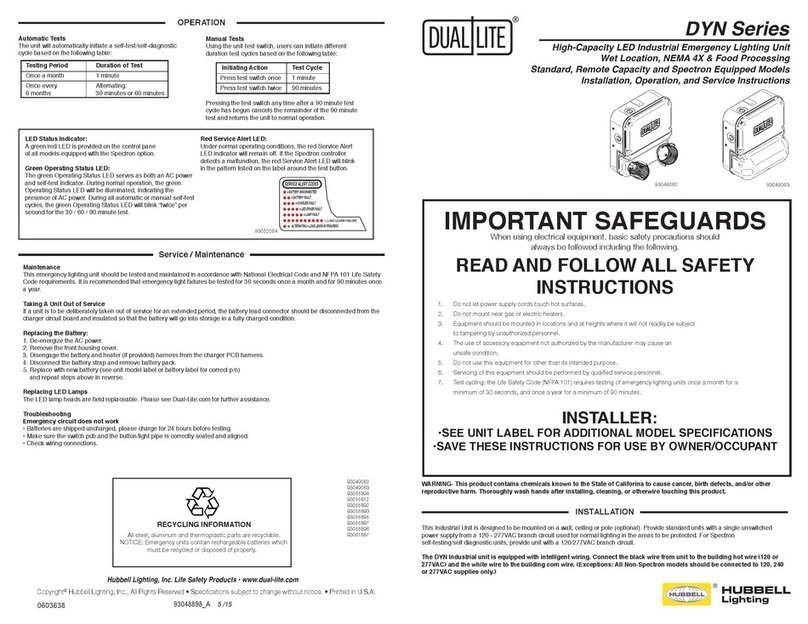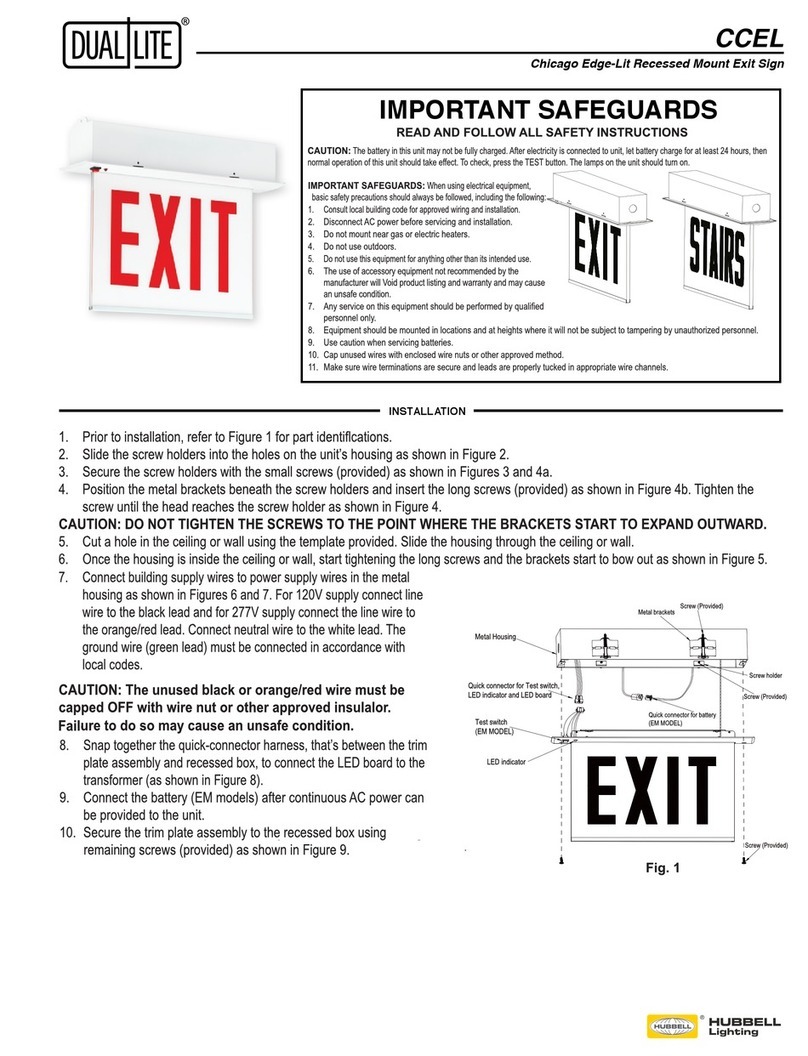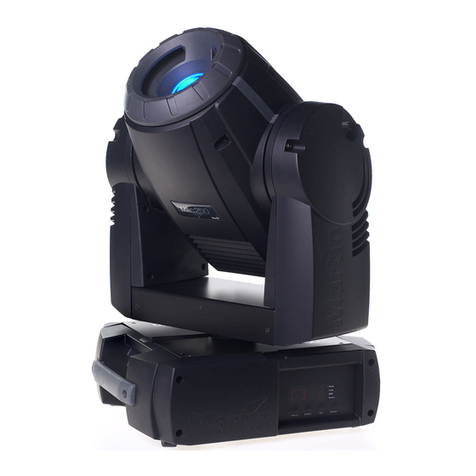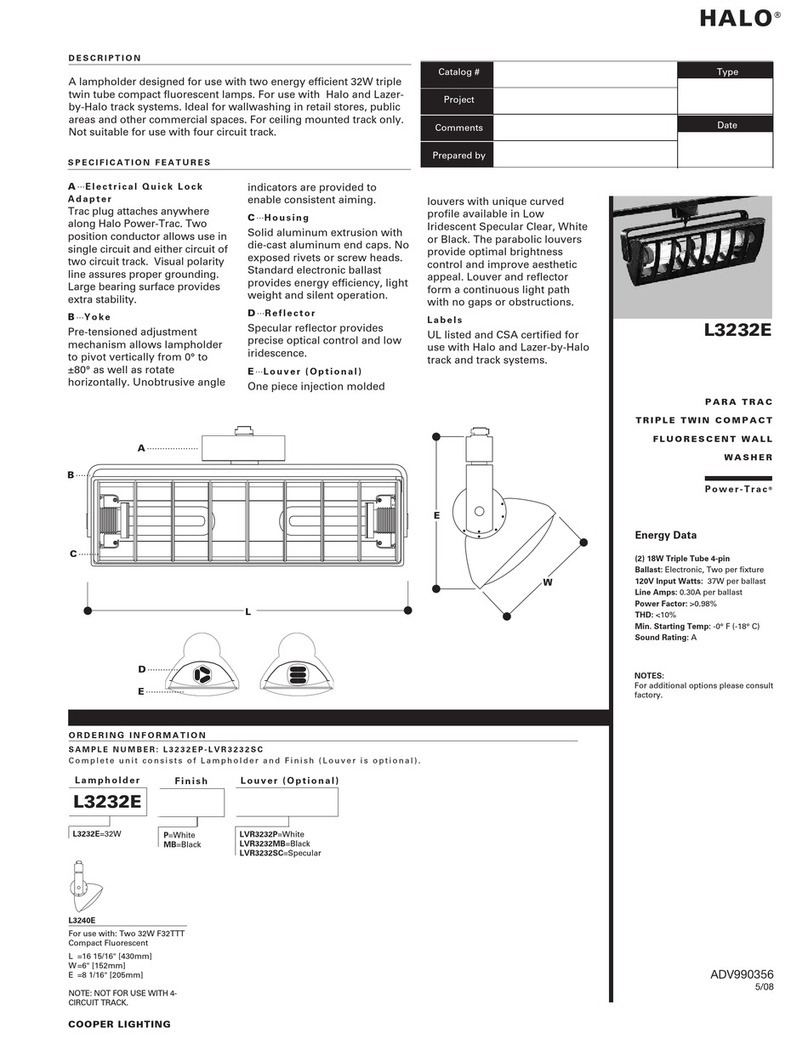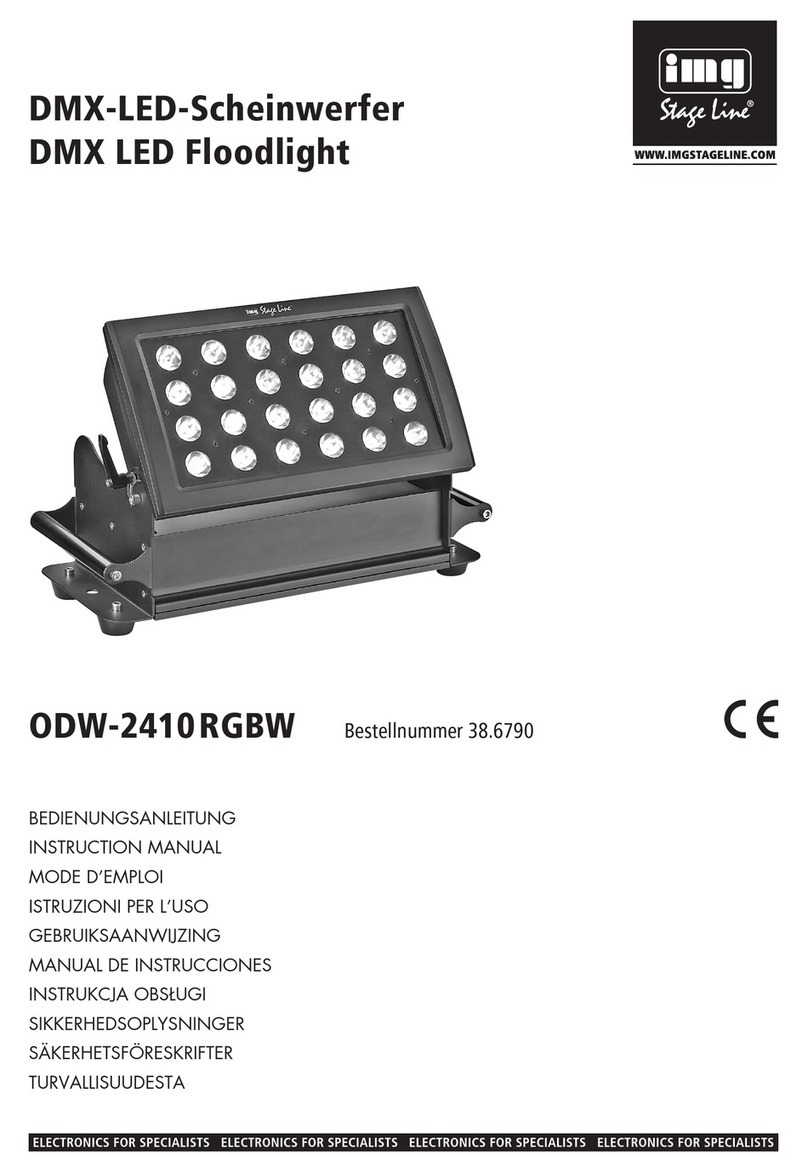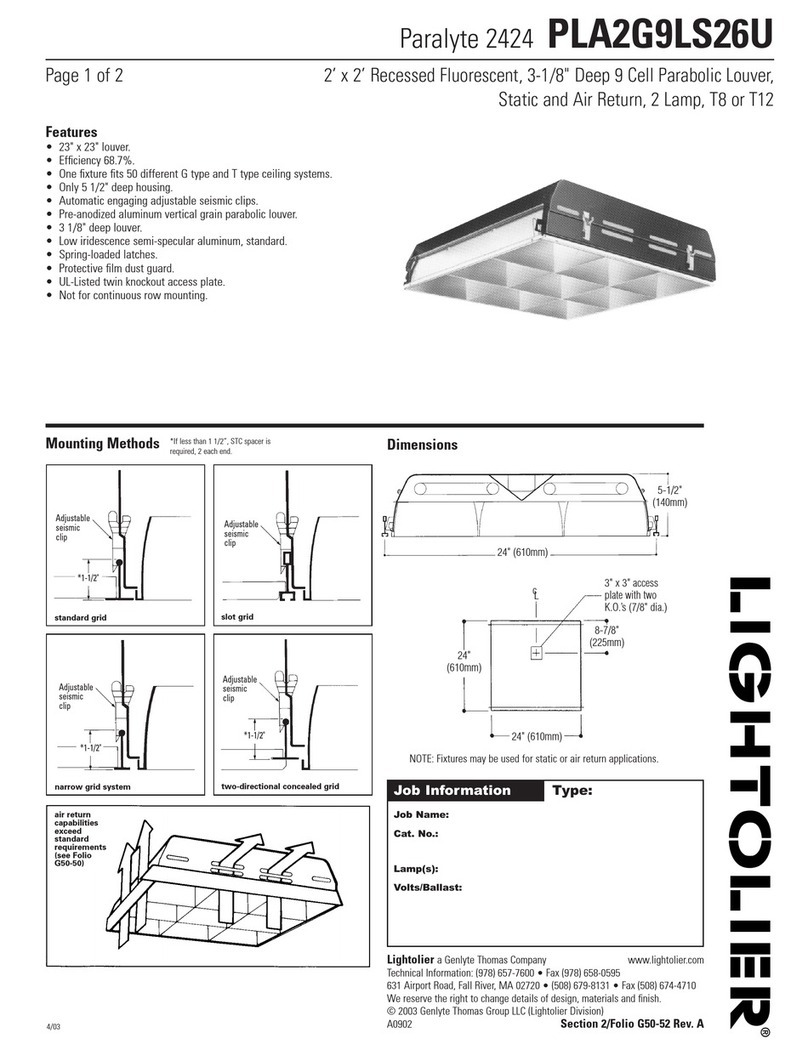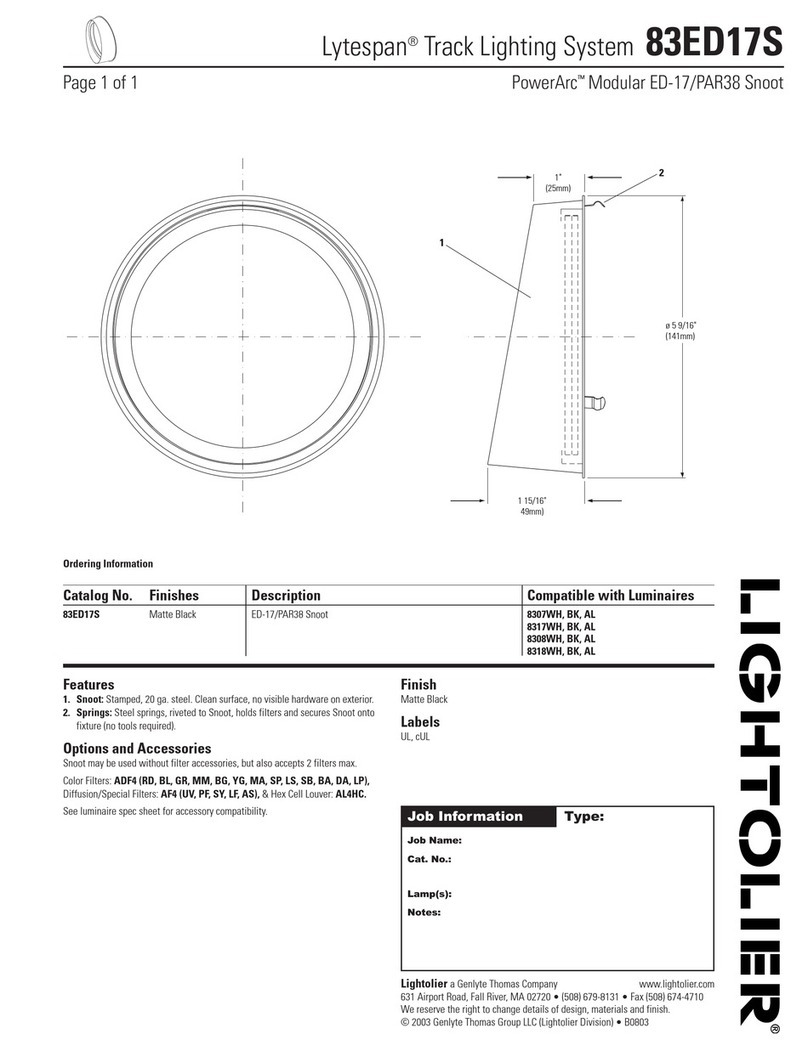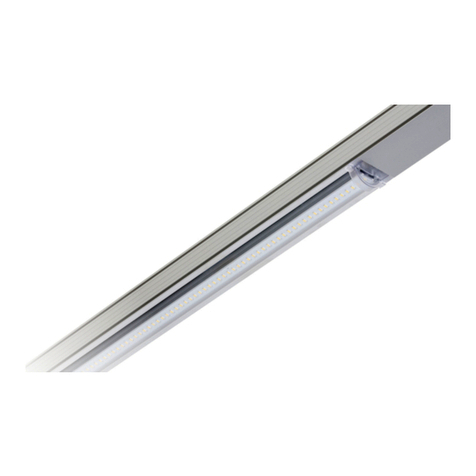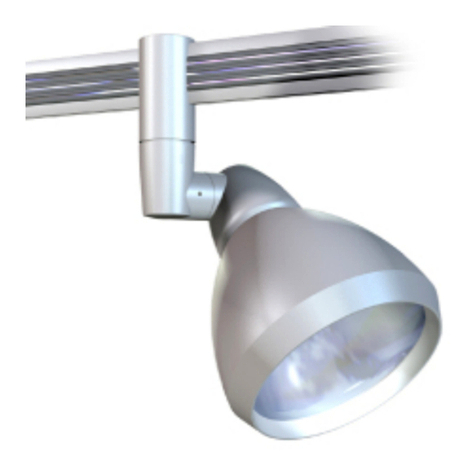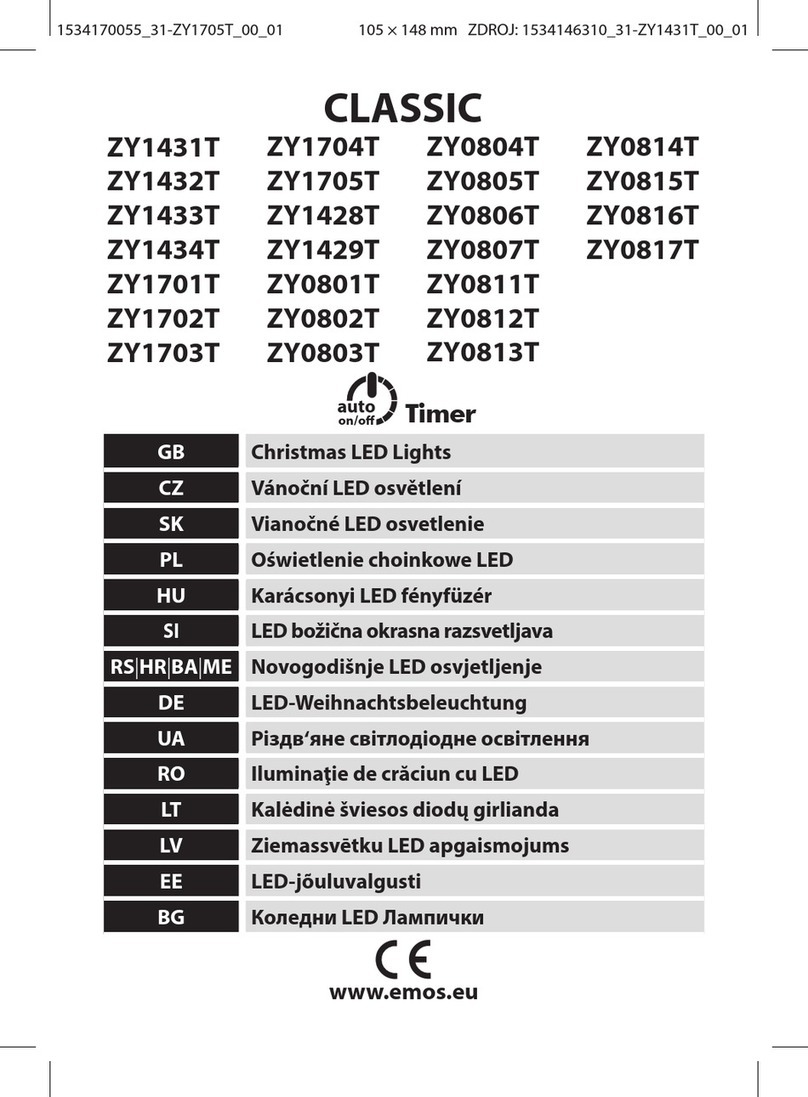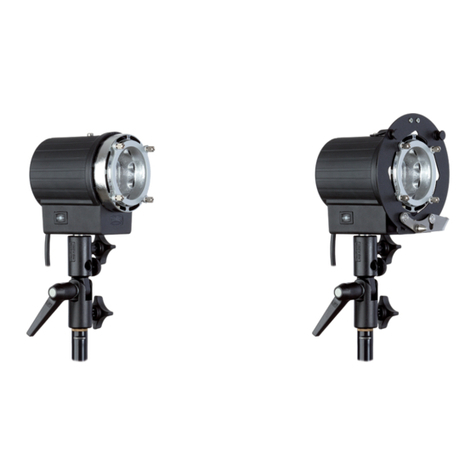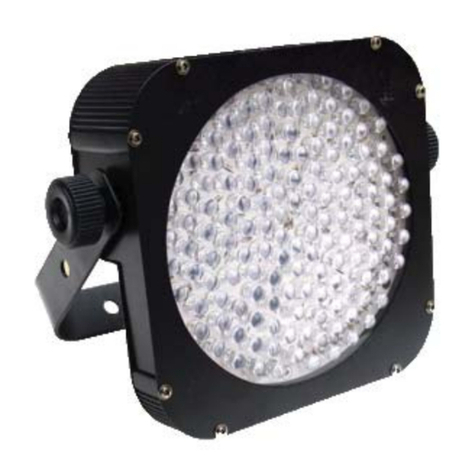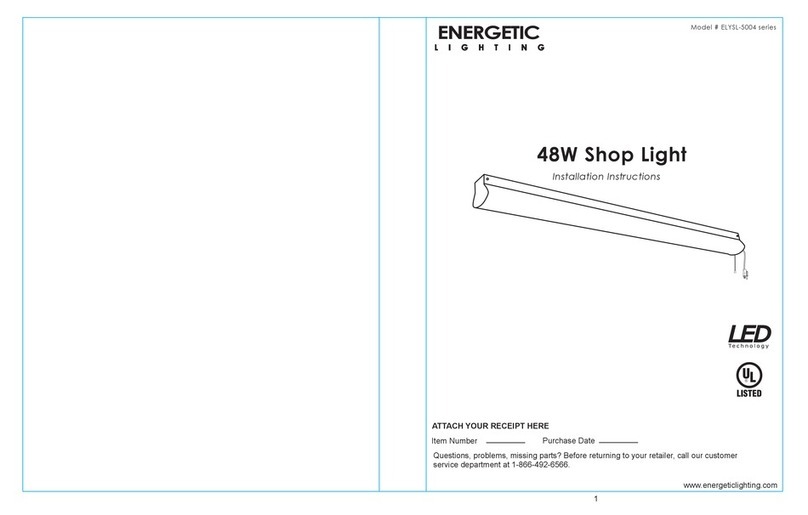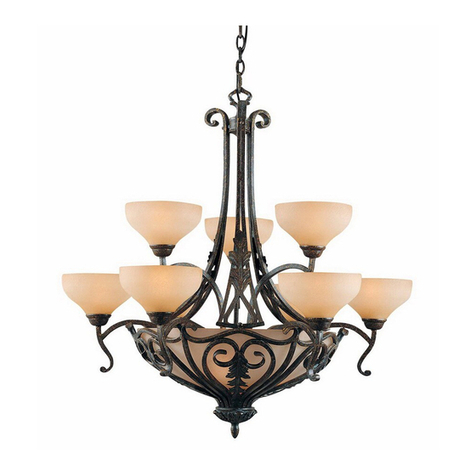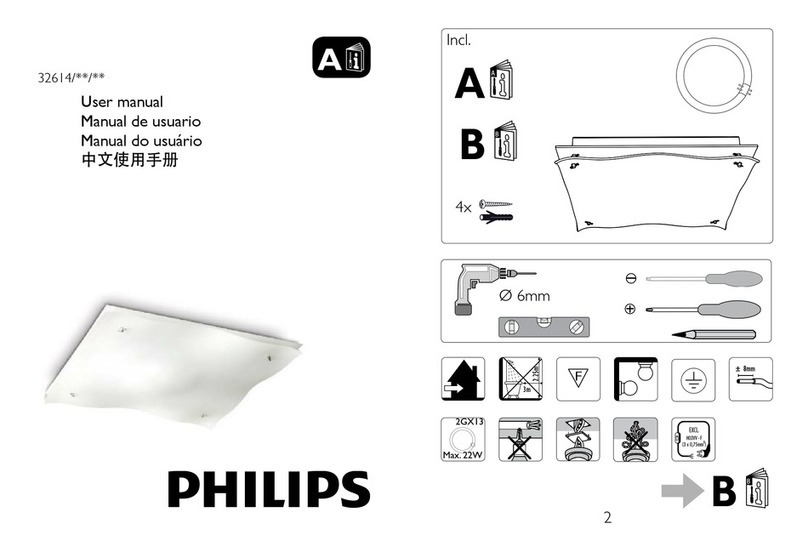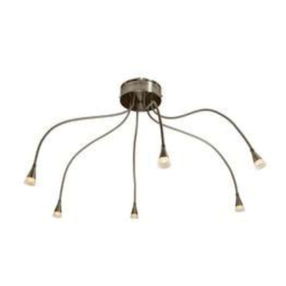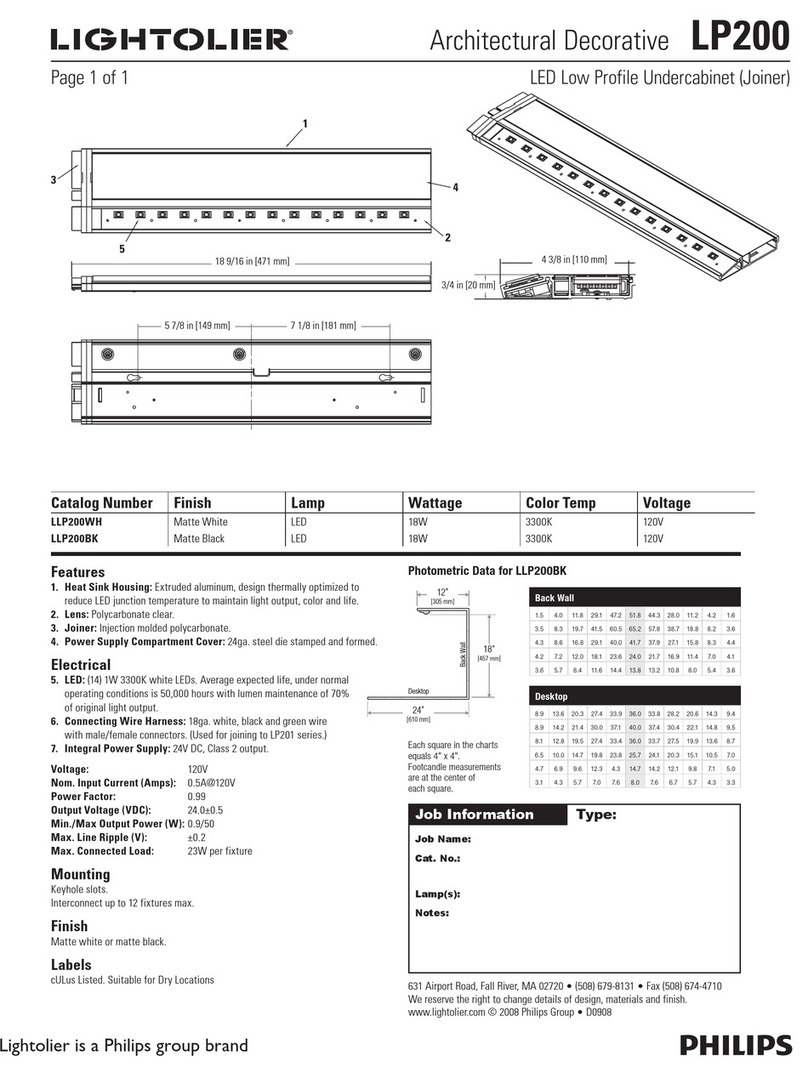
INSTALLATION
WIRING DIAGRAM
WIRING DIAGRAM
Warning:
Unused wires must be capped using enclosed wire nuts.
Fig. A (J-Box) Fig. B Fig. C
J-Box Mounting
1. Feed fixture leads through main bottom case and connect AC power supply (Fig A).
2. Connect wires through J-Box. Main bottom case on J-Box and secure with screws.
3. Connect battery only after continuous AC power can be provided to the unit (Fig. B)
4. Align snaps and push housing directly onto main bottom case (Fig. C). Apply continuous AC power and
press “TEST” button to check light.
Conduit
1. Secure main bottom case to wall surface. Route wires through hole in conduit flange and make
conduit connection.
2. Connect battery only after continuous AC power can be provided to the unit (Fig. B).
3. Align snaps and push housing directly onto main bottom case (Fig. C). Apply continuous AC power and
press “TEST” button to check light.
OPERATION
1. During an electrical power failure, the lamps will automatically come on for a minimum of 90 minutes.
2. To test, depress the “TEST” switch. The emergency lamps will illuminate. When the switch is released,
the lamps will go off.
CU2
CU2RC
INSTALLATION
WIRING DIAGRAM
WIRING DIAGRAM
Warning:
Unused wires must be capped using enclosed wire nuts.
Fig. A (J-Box) Fig. B Fig. C
Instructions for Emergency Lighting Fixture
IMPORTANT:
Small Battery in this unit may not be full charged After electricity
is connected to unit . let batterycharge up for at least 24 hours. Then
normal operation of this unit should take effect . To check, press
the " TEST " button . The light inside the unit should turn on.
IMPORTANT SAFEGUARDS
READ AND FOLLOW ALL SAFETY INSTRUCTIONS
SAVE THESE INSTRUCTIONS
FLEXIBLE CONDUIT ONLY
INSTALLATION (J-BOX MOUNTING)
INSTALLATION (CONDUIT )
When using electrical equipment,basic safety precautions should always be followed including the following:
1.Do not use outdoors.
2.Equipment should be mounted in locations at heights where it will not be subject to tampering by unauthorized personnel.
3.Do not mount near gas or electric heaters.
4.The use of accessory equipment is not recommended by the manufacturer may cause an unsafe condition.
5.Do not use this equipment for other than its intended use.
6.Servicing of this equipment should be performed by qualified personnel.
7.Disconnect AC power before servicing.
1. Feed fixture leads through main botton case and connect AC power supply (Fig A).
2. Connect wires through J-Box. Main bottom case on J-Box and secure with screws.
3. Connect battery only after continuous AC power can be provided to the unit (Fig. B).
4. Align snaps and push housing directly onto main bottom case (Fig. C). Apply continuous AC power
and press "TEST" button to check light.
1. Secure main bottom case to wall surface . Route wires through hole in conduit flange and make conduit
connection.
2. Connect battery only after continuous AC power can be provided to the unit (Fig. B).
3. Align snaps and push housing directly onto main bottom case (Fig. C). Apply continuous AC power
and press "TEST" button to check light.
Fig.A (J-Box) Fig.B Fig.C
WARNING:
Unused wires must be capped using enclosed wire nuts.
The lamps listed herein,when used according to these instructions
with this unit equipment,are in accordance with the requirements of
csa standard C22.2 NO . 141 . Install wiring to remote heads in accor-
dance with section 46 of the canadian electrical code,part I.
PLUG IN
J-Box Mounting
1. Feed fixture leads through main bottom case and connect AC power supply (Fig A).
2. Connect wires through J-Box. Main bottom case on J-Box and secure with screws.
3. Connect battery only after continuous AC power can be provided to the unit (Fig. B)
4. Align snaps and push housing directly onto main bottom case (Fig. C). Apply continuous AC power and
press “TEST” button to check light.
Conduit
1. Secure main bottom case to wall surface. Route wires through hole in conduit flange and make
conduit connection.
2. Connect battery only after continuous AC power can be provided to the unit (Fig. B).
3. Align snaps and push housing directly onto main bottom case (Fig. C). Apply continuous AC power and
press “TEST” button to check light.
OPERATION
1. During an electrical power failure, the lamps will automatically come on for a minimum of 90 minutes.
2. To test, depress the “TEST” switch. The emergency lamps will illuminate. When the switch is released,
the lamps will go off.
READY TEST
CHARGER
BOARD
1. During an electrical power failure, the lamps will automatically come on for a minimum of
90 minutes.
2. To test, depress the "TEST" switch. The emergency lamps will illuminate. When the switch
is released, the lamps will go off.
277 VOLT
120 VOLT
RED
BLACK
WHITE
NEUTRAL
NOTE: UNUSED LEAD TO BE PROPERLY
INSULATED WITH WIRE NUT
OTHER APPROVED METHOD.
RED BLACK
RED
BLACK
BATTERY
LAMP LAMP
3.6V/ 900MAH
RED
BLACK
TEST
CHARGER
BOARD
-
+
1. During an electrical power failure, the lamps will automatically come on for a minimum of
90 minutes.
2. To test, depress the "TEST" switch. The emergency lamps will illuminate. When the switch
is released, the lamps will go off.
277 VOLT
120 VOLT
RED
BLACK
WHITE
NEUTRAL
NOTE: UNUSED LEAD TO BE PROPERLY
INSULATED WITH WIRE NUT
OTHER APPROVED METHOD.
RED BLACK
RED
BLACK
BATTERY
LAMP LAMP
3.6V/ 1800MAH
RED
BLACK
REMOTE
RED
BLACK
INSTALLATION
WIRING DIAGRAM
WIRING DIAGRAM
Warning:
Unused wires must be capped using enclosed wire nuts.
Fig. A (J-Box) Fig. B Fig. C
Instructions for Emergency Lighting Fixture
IMPORTANT:
Small Battery in this unit may not be full charged After electricity
is connected to unit . let batterycharge up for at least 24 hours. Then
normal operation of this unit should take effect . To check, press
the " TEST " button . The light inside the unit should turn on.
IMPORTANT SAFEGUARDS
READ AND FOLLOW ALL SAFETY INSTRUCTIONS
SAVE THESE INSTRUCTIONS
FLEXIBLE CONDUIT ONLY
INSTALLATION (J-BOX MOUNTING)
INSTALLATION (CONDUIT )
When using electrical equipment,basic safety precautions should always be followed including the following:
1.Do not use outdoors.
2.Equipment should be mounted in locations at heights where it will not be subject to tampering by unauthorized personnel.
3.Do not mount near gas or electric heaters.
4.The use of accessory equipment is not recommended by the manufacturer may cause an unsafe condition.
5.Do not use this equipment for other than its intended use.
6.Servicing of this equipment should be performed by qualified personnel.
7.Disconnect AC power before servicing.
1. Feed fixture leads through main botton case and connect AC power supply (Fig A).
2. Connect wires through J-Box. Main bottom case on J-Box and secure with screws.
3. Connect battery only after continuous AC power can be provided to the unit (Fig. B).
4. Align snaps and push housing directly onto main bottom case (Fig. C). Apply continuous AC power
and press "TEST" button to check light.
1. Secure main bottom case to wall surface . Route wires through hole in conduit flange and make conduit
connection.
2. Connect battery only after continuous AC power can be provided to the unit (Fig. B).
3. Align snaps and push housing directly onto main bottom case (Fig. C). Apply continuous AC power
and press "TEST" button to check light.
Fig.A (J-Box) Fig.B Fig.C
WARNING:
Unused wires must be capped using enclosed wire nuts.
The lamps listed herein,when used according to these instructions
with this unit equipment,are in accordance with the requirements of
csa standard C22.2 NO . 141 . Install wiring to remote heads in accor-
dance with section 46 of the canadian electrical code,part I.
PLUG IN
J-Box Mounting
1. Feed fixture leads through main bottom case and connect AC power supply (Fig A).
2. Connect wires through J-Box. Main bottom case on J-Box and secure with screws.
3. Connect battery only after continuous AC power can be provided to the unit (Fig. B)
4. Align snaps and push housing directly onto main bottom case (Fig. C). Apply continuous AC power and
press “TEST” button to check light.
Conduit
1. Secure main bottom case to wall surface. Route wires through hole in conduit flange and make
conduit connection.
2. Connect battery only after continuous AC power can be provided to the unit (Fig. B).
3. Align snaps and push housing directly onto main bottom case (Fig. C). Apply continuous AC power and
press “TEST” button to check light.
OPERATION
1. During an electrical power failure, the lamps will automatically come on for a minimum of 90 minutes.
2. To test, depress the “TEST” switch. The emergency lamps will illuminate. When the switch is released,
the lamps will go off.
READY TEST
CHARGER
BOARD
-
+
1. During an electrical power failure, the lamps will automatically come on for a minimum of
90 minutes.
2. To test, depress the "TEST" switch. The emergency lamps will illuminate. When the switch
is released, the lamps will go off.
277 VOLT
120 VOLT
RED
BLACK
WHITE
NEUTRAL
NOTE: UNUSED LEAD TO BE PROPERLY
INSULATED WITH WIRE NUT
OTHER APPROVED METHOD.
RED BLACK
RED
BLACK
BATTERY
LAMP LAMP
3.6V/ 900MAH
RED
BLACK
1. During an electrical power failure, the lamps will automatically come on for a minimum of
90 minutes.
2. To test, depress the "TEST" switch. The emergency lamps will illuminate. When the switch
is released, the lamps will go off.
277 VOLT
120 VOLT
RED
BLACK
WHITE
NEUTRAL
NOTE: UNUSED LEAD TO BE PROPERLY
INSULATED WITH WIRE NUT
OTHER APPROVED METHOD.
RED BLACK
RED
BLACK
BATTERY
LAMP LAMP
3.6V/ 1800MAH
RED
BLACK
REMOTE
RED
BLACK
CU2
CU2RC
INSTALLATION
WIRING DIAGRAM
WIRING DIAGRAM
Warning:
Unused wires must be capped using enclosed wire nuts.
Fig. A (J-Box) Fig. B Fig. C
Instructions for Emergency Lighting Fixture
IMPORTANT:
Small Battery in this unit may not be full charged After electricity
is connected to unit . let batterycharge up for at least 24 hours. Then
normal operation of this unit should take effect . To check, press
the " TEST " button . The light inside the unit should turn on.
IMPORTANT SAFEGUARDS
READ AND FOLLOW ALL SAFETY INSTRUCTIONS
SAVE THESE INSTRUCTIONS
FLEXIBLE CONDUIT ONLY
INSTALLATION (J-BOX MOUNTING)
INSTALLATION (CONDUIT )
When using electrical equipment,basic safety precautions should always be followed including the following:
1.Do not use outdoors.
2.Equipment should be mounted in locations at heights where it will not be subject to tampering by unauthorized personnel.
3.Do not mount near gas or electric heaters.
4.The use of accessory equipment is not recommended by the manufacturer may cause an unsafe condition.
5.Do not use this equipment for other than its intended use.
6.Servicing of this equipment should be performed by qualified personnel.
7.Disconnect AC power before servicing.
1. Feed fixture leads through main botton case and connect AC power supply (Fig A).
2. Connect wires through J-Box. Main bottom case on J-Box and secure with screws.
3. Connect battery only after continuous AC power can be provided to the unit (Fig. B).
4. Align snaps and push housing directly onto main bottom case (Fig. C). Apply continuous AC power
and press "TEST" button to check light.
1. Secure main bottom case to wall surface . Route wires through hole in conduit flange and make conduit
connection.
2. Connect battery only after continuous AC power can be provided to the unit (Fig. B).
3. Align snaps and push housing directly onto main bottom case (Fig. C). Apply continuous AC power
and press "TEST" button to check light.
Fig.A (J-Box) Fig.B Fig.C
WARNING:
Unused wires must be capped using enclosed wire nuts.
The lamps listed herein,when used according to these instructions
with this unit equipment,are in accordance with the requirements of
csa standard C22.2 NO . 141 . Install wiring to remote heads in accor-
dance with section 46 of the canadian electrical code,part I.
PLUG IN
J-Box Mounting
1. Feed fixture leads through main bottom case and connect AC power supply (Fig A).
2. Connect wires through J-Box. Main bottom case on J-Box and secure with screws.
3. Connect battery only after continuous AC power can be provided to the unit (Fig. B)
4. Align snaps and push housing directly onto main bottom case (Fig. C). Apply continuous AC power and
press “TEST” button to check light.
Conduit
1. Secure main bottom case to wall surface. Route wires through hole in conduit flange and make
conduit connection.
2. Connect battery only after continuous AC power can be provided to the unit (Fig. B).
3. Align snaps and push housing directly onto main bottom case (Fig. C). Apply continuous AC power and
press “TEST” button to check light.
OPERATION
1. During an electrical power failure, the lamps will automatically come on for a minimum of 90 minutes.
2. To test, depress the “TEST” switch. The emergency lamps will illuminate. When the switch is released,
the lamps will go off.
READY TEST
CHARGER
BOARD
1. During an electrical power failure, the lamps will automatically come on for a minimum of
90 minutes.
2. To test, depress the "TEST" switch. The emergency lamps will illuminate. When the switch
is released, the lamps will go off.
277 VOLT
120 VOLT
RED
BLACK
WHITE
NEUTRAL
NOTE: UNUSED LEAD TO BE PROPERLY
INSULATED WITH WIRE NUT
OTHER APPROVED METHOD.
RED BLACK
RED
BLACK
BATTERY
LAMP LAMP
3.6V/ 900MAH
RED
BLACK
TEST
CHARGER
BOARD
1. During an electrical power failure, the lamps will automatically come on for a minimum of
90 minutes.
2. To test, depress the "TEST" switch. The emergency lamps will illuminate. When the switch
is released, the lamps will go off.
277 VOLT
120 VOLT
RED
BLACK
WHITE
NEUTRAL
NOTE: UNUSED LEAD TO BE PROPERLY
INSULATED WITH WIRE NUT
OTHER APPROVED METHOD.
RED BLACK
RED
BLACK
BATTERY
LAMP LAMP
3.6V/ 1800MAH
RED
BLACK
REMOTE
RED
BLACK
CU2
CU2RC
